
Oxon Cove Park and Oxon Cove Farm is a national historic district that includes a living farm museum operated by the National Park Service, and located at Oxon Hill, Prince George's County, Maryland. It is part of National Capital Parks-East. It was listed on the National Register of Historic Places in 2003.
Big Bottom Farm is a farm in Allegany County, Maryland, USA on the National Register of Historic Places. The Greek Revival house was built circa 1845, possibly by John Jacob Smouse, and exhibits a level of historically accurate detailing unusual for the area. The property includes a late 19th-century barn and several frame outbuildings.
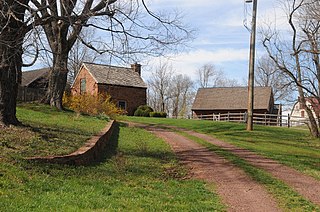
Darnall Place is a historic farm complex located at Poolesville, Montgomery County, Maryland, United States. The farm complex consists of four small 18th-century stone buildings, a 19th-century frame wagon shed/corn crib, a 20th-century concrete block barn, and three late-19th- or early-20th-century frame sheds. The stone buildings are all constructed of red-brown Seneca sandstone. The one-story dwelling has a large external stone chimney on the east end. The farmstead is reminiscent of those in Europe or the British Isles.
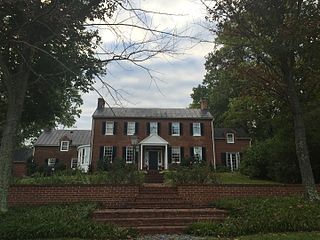
East Oaks is a historic home and farm complex and national historic district located at Poolesville, Montgomery County, Maryland. It is a 156-acre (0.63 km2) farm complex consisting of a 2+1⁄2-story, c. 1829 Federal-period brick residence situated on a knoll surrounded by agricultural buildings and dependencies whose construction dates span more than a century. The complex of domestic and agricultural outbuildings includes a brick smokehouse, sandstone slave quarter, stone bank barn, stone dairy, and log and frame tenant house which are contemporaneous with the construction of the main dwelling. Other agricultural buildings include a small frame barn and machinery shed/corn crib from the end of the 19th century, and a block dairy barn from the mid 20th century.
McPherson's Purchase is a historic farm complex dating to the 19th century and located near Pomfret, Charles County, Maryland, United States.

Thainston is a farm complex and national historic district in La Plata, Charles County, Maryland, United States. The main house is a two-story, L-shaped brick house built in 1865 and enlarged early in the 20th century. It was designed by Eben Faxon, a Baltimore architect, and constructed under the supervision of Charles Ogle, a building contractor also from Baltimore. The farm developed between 1865 and the 1930s. Included on the property are a number of early dependencies, including a wellhouse, a brick dairy, a storage building, and a meathouse. A frame garage and large chicken house, both dating from the early 1900s, are on the property. There is also a collection of agricultural buildings including: tobacco barns, cattle barns, and equipment sheds clustered around a corncrib/granary. There are three frame tenant houses, several associated sheds, a probably early building site, an early well, a pit remaining from a former ice house, and the former ice ponds. Another early-20th century building, a tobacco barn, stands in a field to the west of the main grouping of agricultural buildings.

Rose Hill Manor, now known as Rose Hill Manor Park & Children's Museum, is a historic home located at Frederick, Frederick County, Maryland. It is a 2+1⁄2-story brick house. A notable feature is the large two-story pedimented portico supported by fluted Doric columns on the first floor and Ionic columns on the balustraded second floor. It was the retirement home of Thomas Johnson (1732–1819), the first elected governor of the State of Maryland and Associate Justice of the United States Supreme Court. It was built in the mid-1790s by his daughter and son-in-law.

Rich Mountain is a historic home and farm complex located at Frederick, Frederick County, Maryland, United States. It is on the remaining 10-acre (40,000 m2) tract from the original farm. The complex consists of a stone dwelling dating from 1810 to 1820 with a one-story kitchen wing; a 19th-century frame Pennsylvania barn; and a hog barn, wagon shed / corn crib, equipment shed, and chicken coop. The house combines Federal style elements with regional vernacular features.

The Routzahn-Miller Farmstead is a historic home and farm complex located at Middletown, Frederick County, Maryland, United States. It consists of a Federal style-influenced brick house and smokehouse, both built about 1825; a later frame out-kitchen / washhouse; a standard Pennsylvania barn; a 20th-century dairy barn and milk house; and a 20th-century equipment shed. The Pennsylvania barn was probably built in the late 19th century and was recently rehabilitated for use as a preschool. The complex is located on a 16.7-acre (68,000 m2) parcel on the east flank of South Mountain. It is representative example of a type of domestic and agricultural grouping which characterized the rural mid-Maryland region from the early 19th century through World War II era.
The Daniel Sheffer Farm is a historic home and farm complex located at Middletown, Frederick County, Maryland, United States. It is dominated by the two story brick main house, which was constructed between 1840 and 1850. Outbuildings include a stone spring house, a large wood-frame barn, constructed about 1900, and several wood-frame outbuildings including a corncrib, a wagon shed, three frame wood sheds, two tractor sheds, and a chicken house. A concrete block milk house and terra cotta silo were added to the complex in the 1930s. In September 1862, the property served as a temporary hospital for wounded soldiers during the Battle of South Mountain in the American Civil War.

The George Markell Farmstead, also known as Arcadian Dairy Farm and the Thomas Property, is a historic home and farm complex located at Frederick, Frederick County, Maryland, United States. It consists of brick house built about 1865, a brick smokehouse, a bake oven, two stone domestic outbuildings, an ice house, a springhouse, a frame stable, a frame chicken house, a mid-20th century guest house, and various sheds and outbuildings. Nearby is a large gambrel-roofed concrete block barn. The main house has combined Greek Revival and Italianate stylistic influences. The once large Markell dairy farm, with its lane to the Ballenger Creek ford of the Monocacy River, served as the primary approach route to the battlefield by Confederate troops during the July 9, 1864 Battle of Monocacy during the American Civil War.
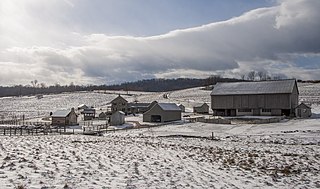
Peter of P. Grossnickel Farm is a historic home and farm complex located at Myersville, Maryland, Frederick County. It consists of a mid-19th-century, Greek Revival farmhouse and 13 related buildings and structures. The house is a 2+1⁄2-story stone center-passage house on a limestone foundation, with a 1+1⁄2-story kitchen wing and 18-inch-thick (460 mm) walls. The house was built between 1840 and 1850. Also on the property is an 1881 tenant house with corresponding barn, spring house, and washhouse / privy; an 1884–1897 bank barn; a pre-1830 granary; a 19th-century wood shed; late-19th-century hog pen / chicken house; a pre-1830 beehive oven; a late-19th-century smokehouse; a spring house with a Late Victorian cottage addition; and early-20th-century concrete block milk house; and a log summer kitchen of unknown date. The Grossnickel family was a German American family who were instrumental in the establishment of the Grossnickel Church of the Brethren.
Kitterman–Buckey Farm is a historic home and farm complex located at Johnsville, Frederick County, Maryland. It is the remnant of the farm that was established by the German immigrant Christopher Kitterman in 1752, and which remained in the Root/Buckey family from 1790 to 1919. The main house was built about 1752 and is two stories in height. It is composed of two halves, built probably 40 to 50 years apart, and united under a low-sloping slate roof with three chimneys, with additions made in the 19th century and again in the 1950s and 1980s. Also on the property are a springhouse and cabin / smokehouse both dating to about 1752, a machine shed, horse barn built about 1930, a bank barn built about 1850, and a silo from 1934.
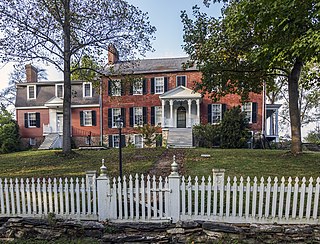
Hopewell is a set of historic homes and farm complexes located at Union Bridge, Carroll County, Maryland, United States. It consists of four related groupings of 19th century farm buildings. The Hopewell complex consists of two historic farms: Hopewell and the smaller F.R. Shriner Farm.
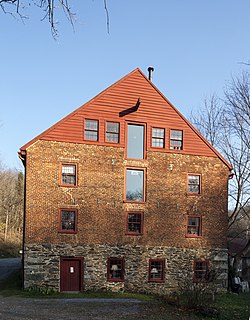
Lewis Mill Complex is a historic grist mill complex located at Jefferson, Frederick County, Maryland. The complex consists of seven standing structures, a house foundation, and the remains of an earlier millrace. It centers on an early 19th-century three-story brick mill structure with a gabled roof. The mill complex served German immigrant farmers in Middletown Valley between 1810 and the 1920s. It was rehabilitated in 1979-1980 for use as a pottery shop. Also in the complex are a stuccoed log house and log springhouse built about; a frame wagon shed and corn crib structure and frame barn dating from the late 19th century; and early 20th century cattle shelter and a frame garage.
Kefauver Place is a historic farm complex located at Rohrersville, Washington County, Maryland, United States. It includes a log cabin built about 1820; a log barn of about 1830 with later-19th-century additions; a 19th-century timber-framed corn crib; a two-story brick house constructed around 1880; an early-20th-century masonry root cellar; and a frame summer kitchen, hog pen, chicken house, and garage all dating from about 1930. Also on the property are two fieldstone spring enclosures. It is located on a 21-acre (85,000 m2) property.
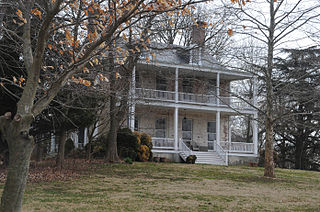
Octorara Farm is a historic home located at Conowingo, Cecil County, Maryland, United States. It was built in sections dating from the period between 1775 and 1840. The main block is a 2+1⁄2-story brick structure of high style Greek Revival architecture; it was probably added to the earlier rear section around 1830–1840. The present kitchen, which constitutes the central room of the three rooms of the rear section, is the earliest section of the house, probably dates to about 1775. Also on the property are a large four-bay fieldstone barn, a wagon shed, dairy, smokehouse, and tenant houses.
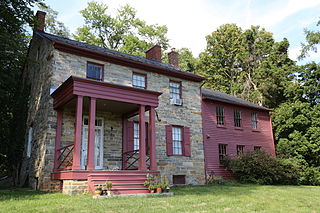
Woodside is a historic home located at Abingdon, Harford County, Maryland. It has a 2+1⁄2-story main section, designed in 1823, that is an excellent example of a Federal side hall, double parlor plan house. The house is constructed of coursed fieldstone and ashlar. The property includes a stone house with overhanging gable roof, a hand pump, a shed-roofed frame storage building, an 1848 log barn, a 1928 frame corn crib, and three early 20th century garages.

Carroll County Almshouse and Farm, also known as the Carroll County Farm Museum, is a historic farm complex located at Westminster, Carroll County, Maryland. It consists of a complex of 15 buildings including the main house and dependencies. The 30-room brick main house was originally designed and constructed for use as the county almshouse. It is a long, three-story, rectangular structure, nine bays wide at the first- and second-floor levels of both front and rear façades. It features a simple frame cupola sheltering a farm bell. A separate two-story brick building with 14 rooms houses the original summer kitchen, wash room, and baking room, and may have once housed farm and domestic help. Also on the property is a brick, one-story dairy with a pyramidal roof dominated by a pointed finial of exaggerated height with Victorian Gothic "icing" decorating the eaves; a large frame and dressed stone bank barn; and a blacksmith's shop, spring house, smokehouse, ice house, and numerous other sheds and dependencies all used as a part of the working farm museum activities. The original Carroll County Almshouse was founded in 1852 and the Farm Museum was established in 1965.
George Maddox Farm, also known as Cottage Hall Farm or Albert Sudler Farm, is a historic farm complex located at Manokin, Somerset County, Maryland. It is an intact complex of 15 agricultural buildings and structures dating from about 1800 through the early 20th century. The complex includes six pre-Civil War structures including a frame granary, two dairies, a log smokehouse, another (ruined) log outbuilding, and a frame kitchen/quarter. Seven post-war structures include a barn, two garages, tenant house, privy, well house, and chicken house. The main house is a 2+1⁄2-story irregular-plan Queen Anne house, roughly cruciform in plan. An early-19th-century single-story kitchen extends from the back of the house.


















